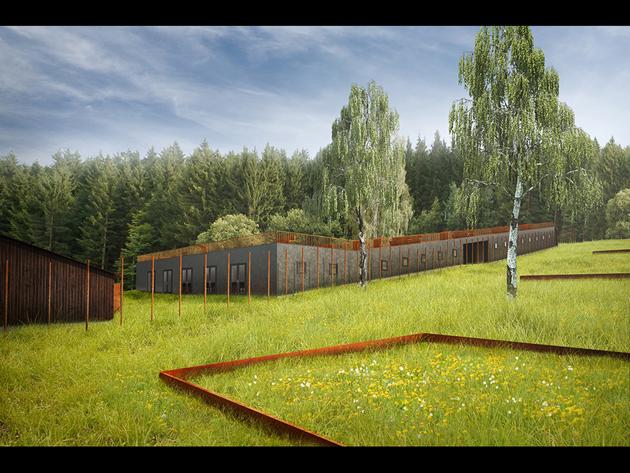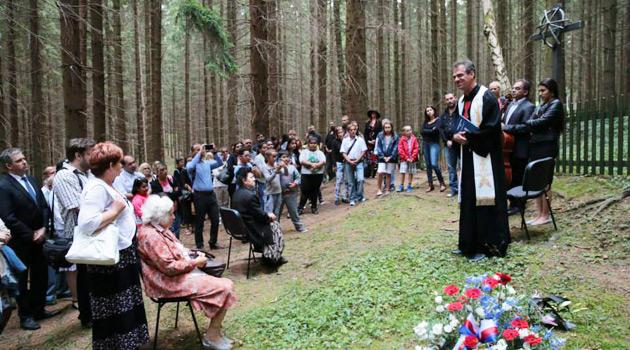Czech Govt to open memorial at Hodonín camp next year honoring its WWII, post-war and Communist-era victims

Construction work has finished on the memorial in Hodonín by Kunštát (Blansko district) that will tell the stories of the WWII-era transit camp there for Moravian Roma, the internment center there for the Germans expelled post-war, and the forced labor camp in operation there from the 1950s. The total cost for purchasing the campus, reconstructing it and creating the exhibitions is CZK 98 million (EUR 3.6 million).
Markéta Pánková, director of the J. A. Comenius National Pedagogical Museum and Library, which is administering the memorial, said the construction work took roughly five years and it will now take one year to install the exhibitions. “Unless some problem arises, all will be ready by next August,” the director said.
It cost CZK 20 million (EUR 740 000) to buy the former recreation center on the site from the private owner and CZK 78 million (EUR 2.9 million) to construct and renovate the buildings there and create the exhibitions. “Of the seven prison buildings, only one was preserved, which we have reconstructed, as well as the guards’ building, which was also partially preserved. We have also erected a new building as an infocenter,” the director said at a press conference last week.
All three buildings will house exhibitions telling the history of the site. “We did our best to restore the landscape to its original form as well. We have fenced off the remembrance site and erected a stake for each person who died there. There are 288 stakes, 207 for the Romani prisoners and 81 for the Germans who died there during the expulsion,” the director said.
The exhibition will feature Czech and English texts, photographs, objects, and short film interviews with eyewitnesses describing the life of both prisoners and guards. “There will be, for example, a list of those who died there, a timeline showing what was happening in the Czech lands, in Europe, and at the camp, as well as telephone booths that will make it possible to listen to audio records of some of the eyewitnesses,” the director said.
The exhibition will serve as an educational center for schools and the public, and the director said it is important to create such memorials. “This is important now, when people are being imprisoned and killed, to prevent something like what happened then from repeating itself,” she said.
History of the construction of the memorial since 2009
On the basis of Government Decree No. 589 of 4 May 2009, the Czech Education Ministry received funding to purchase the campus and implement the project in 2009. The memorial replaces what was a recreation center in Hodonín (Blansko district).
In 2012 the Czech Education Ministry transferred the campus to the J.A. Comenius National Educational Museum and Library (NPMK), a contributory organization established by the ministry, which then began its own construction work. After a prelimiary archeological survey of the site, the NPMK implemented the reconstruction of the preserved prisoner barracks.
As a result that building now faithfully recalls the form of one of the barracks from the time of the so-called “Gypsy camp” at the site, i.e., 1942-1943. In 2013 the NPMK organized a student competition for designs for the rest of the Memorial among students of university architecture departments in the Czech Republic, and 90 students submitted 30 proposals.
The winning design by Richard Pozdníček was implemented during 2015-2016 by a team of planners led by Petr Labonek under the supervision of technical supervisor Radoslav Hošek from the PORR company. The campus is a combination of the two preserved original buildings from the camp (the guards’ barracks and prisoners’ barracks), reconstructed, authentic landscaping, and other original elements from the former camp alongside a sensitively-conceived new building as the infocenter (housing the main exhibition), and as a whole it facilitates the serving of all the functions expected of the Memorial and creates an appropriate backdrop for the permanent educational exhibitions there.
Memorial to the tragic events of the 20th century
In addition to the infamous so-called “Gypsy camp” at Lety by Písek, which was intended for Romani people from Bohemia, the transit camp at Hodonín is also notorious as the place where Moravian Roma were forcibly brought together during the war prior to being transported to Auschwitz. The Hodonín camp, however, is different in that over the course of its existence it was used to isolate various other groups of “non-conforming” members of the Czechoslovak population who were excluded from society.
The history of the camp at Hodonín embodies the history of Czechoslovakia. It was first a disciplinary labor camp, then the so-called “Gypsy” transit camp, then an internment center for the expulsion of the Germans, and then a forced labor camp during the 1950s.
During the Second World War more than 2 000 such places existed for the imprisonment of (not just) Czechoslovak citizens (transit camps, internment camps, labor and concentration camps). The memorial, once completed, will primarily present the sad history of Romani people as part of Czech history, more specifically, Czechoslovak and European history.
